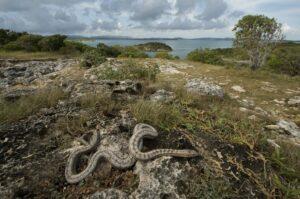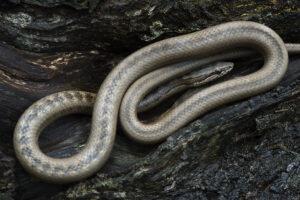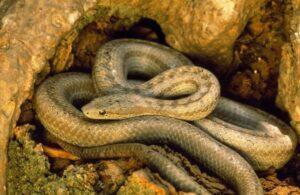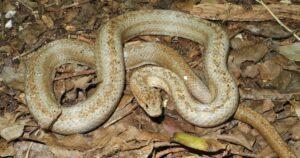The Antiguan racer is one of the rarest snakes in the world. In recent years vigorous conservation efforts have increased its population from 50 to 1100. As the name suggests, it is a native of Antigua and Barbuda and almost all the islands off the Antiguan bank. Despite its name, the snake is quite slow-moving. But it is a good swimmer, undulating its body in water like an eel, and can jump 18-20 ft.
Scientific Classifications
- Suborder:Serpentes
- Family:Colubridae
- Genus:Alsophis
- Species:A. antiguae
Conservation Status
Description
Size
Adults are mostly 40 inches (1 meter) in length, with the females being longer than the males.
Color and Appearance
The species exhibits sexual dimorphism. Young adult males are generally dark brown overlaid with light creamy patterns, while females of the same age are silver-gray with dull brown markings and patches. The females have bigger heads than males. Older snakes of both sexes vary a lot in their colors and patterns. They are often heavily blotched or speckled in various colors like reddish brown, black, white, brown, and taupe.
The snakes of this species have small heads with elliptical pupils that help them to swivel around when looking for food.
Are They Dangerous to Humans
Having a gentle temperament, this snake is harmless to humans. When threatened, they release a musky smell and can bite to scare off the attacker. But being non-venomous, its bite is not a cause for alarm.
Antiguan Racers at a Glance
Distribution

The snake inhabits the Great Bird Island, Green Island, Rabbit Island, and York Island off the coast of Antigua, in the eastern Caribbean Sea.
Habitat
The Antiguan Racer prefers living in shady woodlands with thick undergrowth. But it can also be found in rocky outcrops and sandy beaches.
Being diurnal, it is active from dawn to dusk. At night, it takes rest in a hidden shelter.
Lifespan
The colubrid lives for around 15-20 years.

Predators
The snake has no natural predator.
Diet
Its primary diet consists of lizards, mostly the local Antiguan ground lizard. Though it occasionally hunts for its food, it is basically an ambush predator, hiding under leaves as it waits for its prey.
Reproduction
Oviparous (lays eggs that hatch outside the body)
Every 2-3 years, a female lays clutches of 3-4 eggs in tree cavities or moist soil below rocks. Fully developed babies hatch from the eggs.
FAQs
Ans. In the 1800s, invasive black rats were becoming a nuisance to sugar cane plantation owners in Antigua. So they introduced Asian mongooses to kill the rats. But the latter were nocturnal while the former were diurnal. So instead of the rats, the mongooses preyed on Antiguan racers to the extent that they were entirely wiped off from Antigua, except for a small population on the Great Bird Island, where there were no mongooses.
Since then, the other small islands of the region have been cleared of predators and populated with the snakes to increase their number to around 500. Still, humans continue to threaten the remaining population by killing them, considering them dangerous.
Source
mediastorehouse.com, assets3.thrillist.com, zslpublications.onlinelibrary.wiley.com live.staticflickr.com







